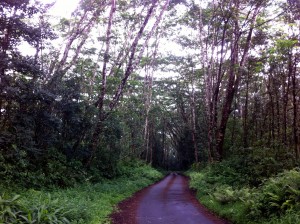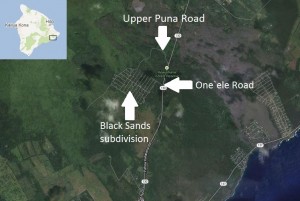Government Crews Kick Up Albizia Effort
The government this week will kick the fight against the albizia tree up a notch in lower Puna.
The effort involves the Big Island Invasive Species Committee’s Abizia Demonstration Project in the Keau`ohana State Forest Reserve and nearby Black Sands subdivision.
Joining the BIISC in the latest effort, scheduled from Wednesday through Friday, will be personnel from the state Department of Land and Natural Resources and the county Department of Public Works.
The current project will focus on Upper Puna Road, which intersects with Highway 130 just north of the 17-mile marker on Highway 130.
Albizia trees within 100 feet of the road and considered a threat to motorists will be cut down. Smaller trees will be converted into chips and larger trees removed entirely.
The BIISC will follow-up by applying herbicide to stumps to prevent re-growth and to kill other trees not considered an immediate hazard using methods developed by the University of Hawai’i extension program and the US Forest Service.
The tag-team effort will allow crews to cover both county and state right-of-ways and synchronize their efforts.

These albizia trees along Upper Puna Road will be targeted in a control effort this week. BIISC photo.
“This project demonstrates how all stakeholders, government, private sector, and residents, can work together to manage the albizia problem in more cost-effective ways,” BIISC Manager Springer Kaye said in a statement.
According to forest service ecologist Flint Hughes, albizia, one of the world’s fastest-growing trees, is a statewide ecological and public safety problem.
“Albizia’s rapid and pervasive growth destroys native forests by shading out native plants and improving conditions other invasive flora, such as strawberry guava,” Hughes said. “On top of that, the tree’s brittle branches and shallow roots easily break in wind or rain, then fall on homes, roads, and power lines.”
When state lawmakers funded the 500-acre demonstration project last year, they also directed BIISC to develop an albizia-management plan that could be used statewide.
The project area includes albizia overhanging homes and roads, as well as spreading in native lowland forest.
“Stakeholders identified this area of Puna as a case study to showcase the wide range of issues in albizia control, develop best management practices, and empower communities to limit the spread of these menacing trees in their own neighborhoods,” Kaye said.
Since December, BIISC has also held three “Community Training Workshops” where the public can learn how to use herbicide to safely and effectively kill albizia trees that are not threatening infrastructure.
More are scheduled next week, which is also Hawai`i Invasive Species Awareness Week.
The days and locations of the workshops, which will be held from 9 a.m. to 2 p.m., include:
- Tuesday, March 4, on the south side of the Puainako Street Extension, 1.5 miles mauka of Komohana Street
- Wednesday, March 5, in the Carvalho Park upper parking lot on Waianuenue Avenue
- Thursday, March 6, on the Puainako Street Extension, in the same location as the Tuesday workshop
- Saturday, March 8, at the intersection of Highway 130 and Upper Puna Road near the Black Sands subdivision.
For information on Community Training Workshops, contact BIISC at 933-3340.












